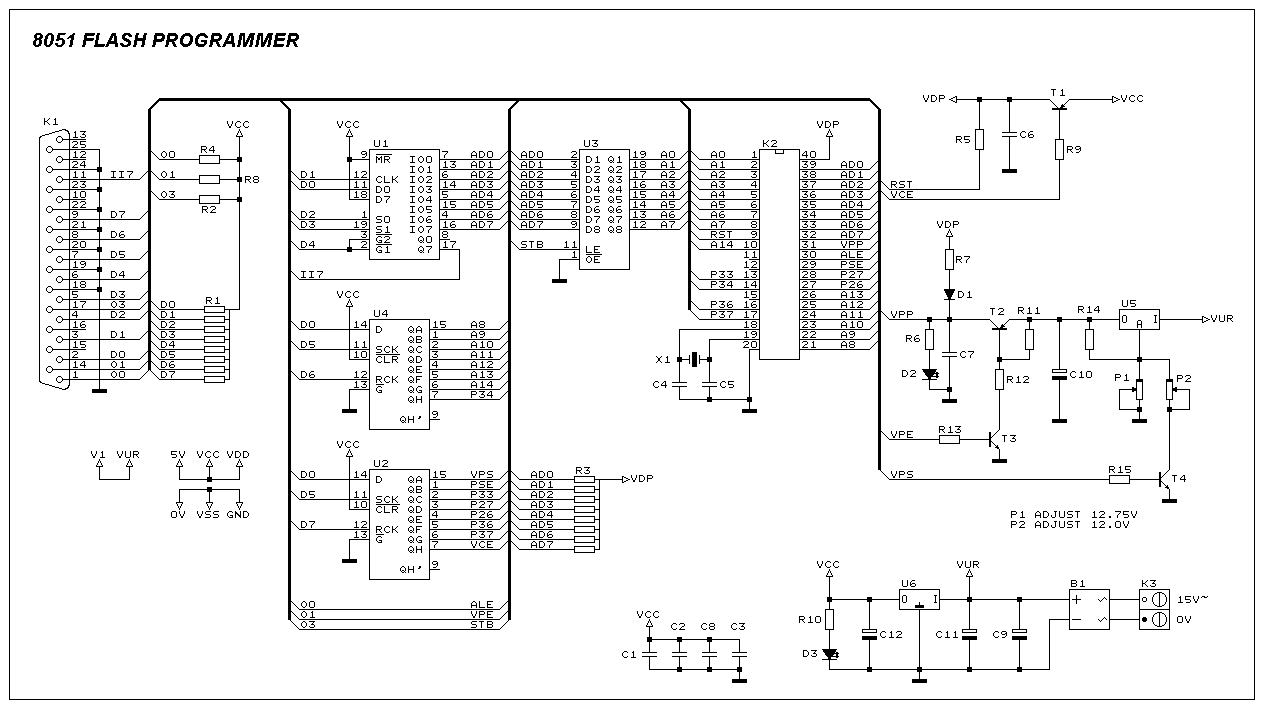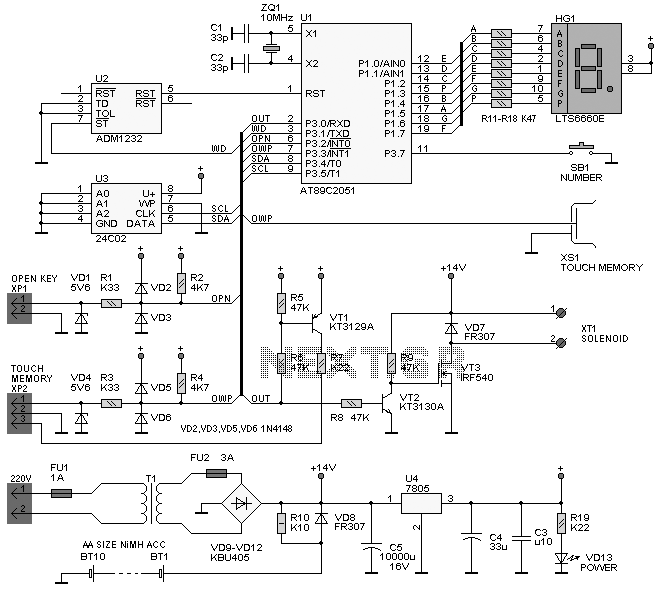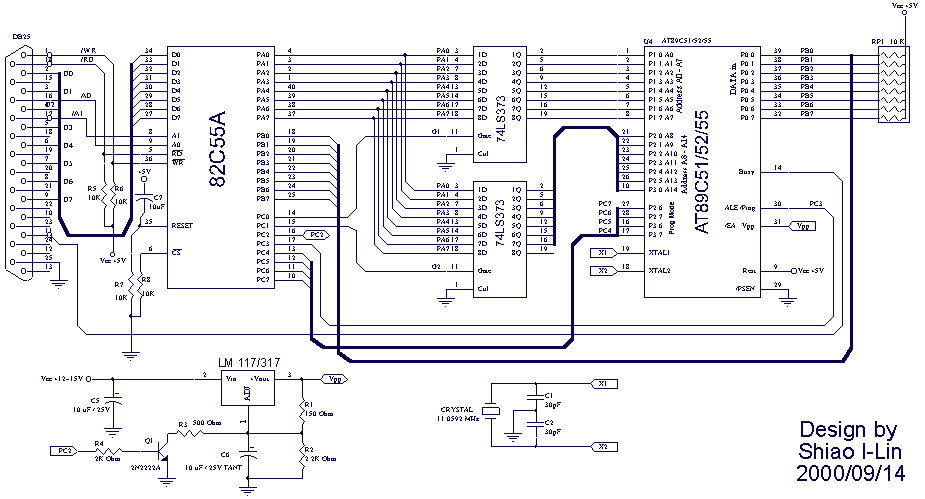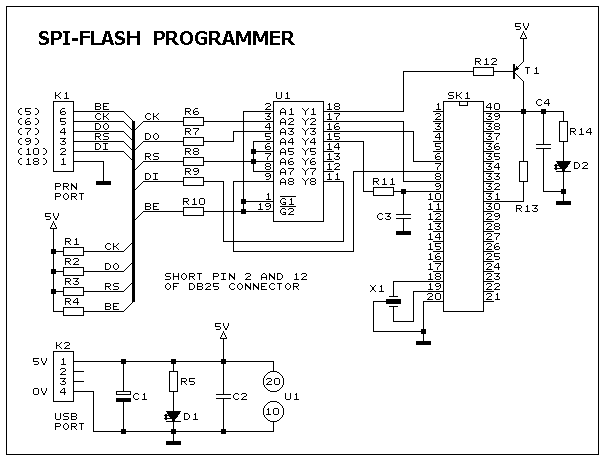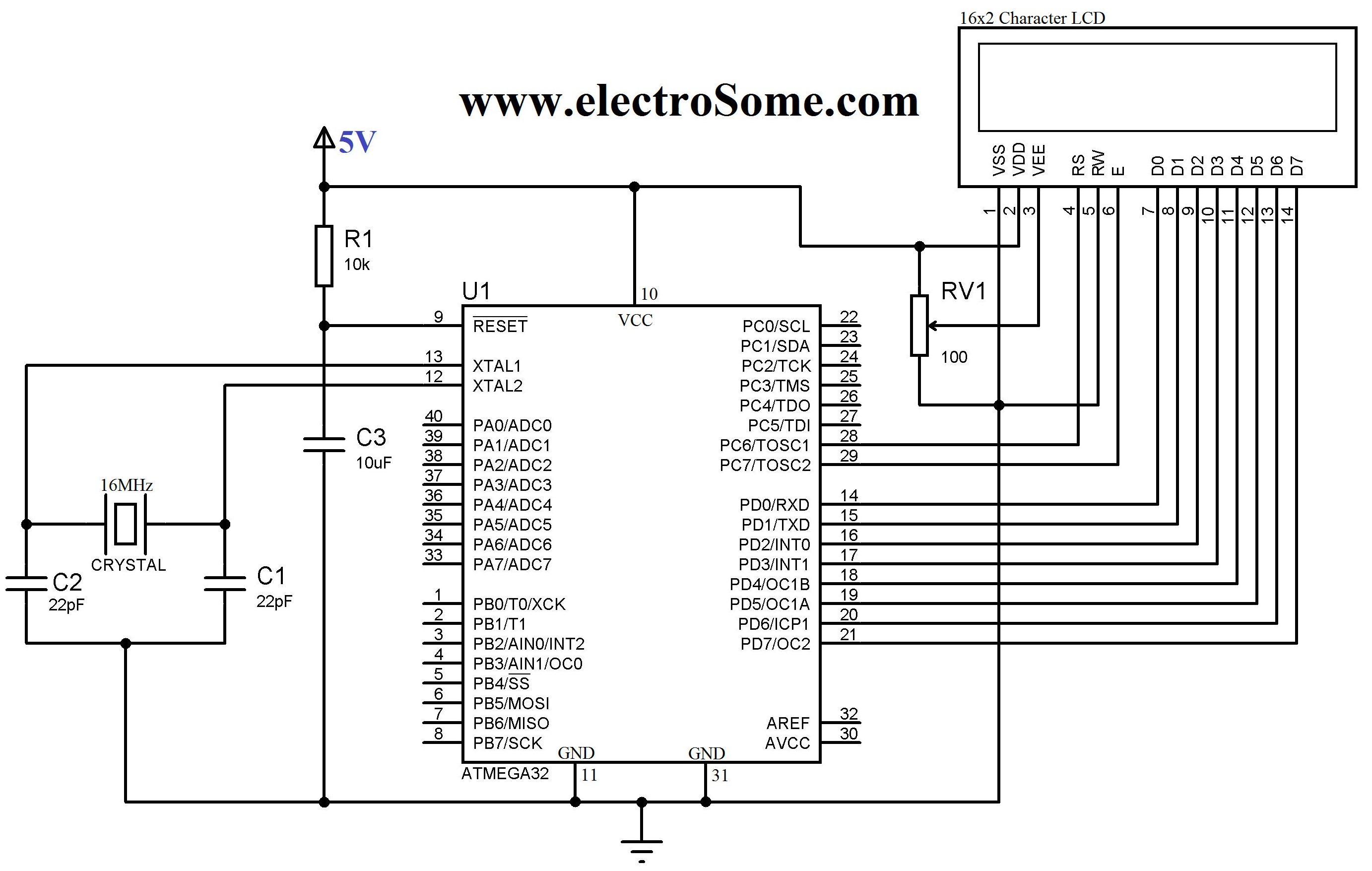
Atmel At90S2313 Countermeasures
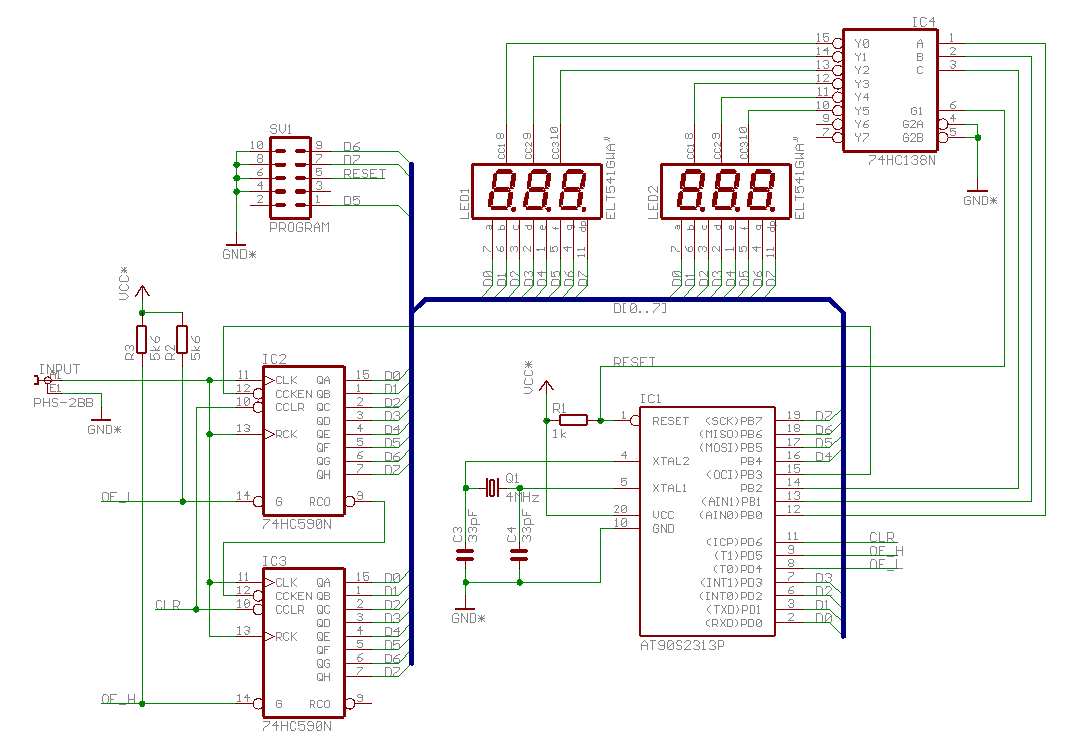
This project meets a specific need by utilizing a frequency counter built with basic TTL chips, predating the availability of CMOS HC versions. The design incorporates four chips: three HC TTLs and an Atmel AT90S2313 microcontroller. It features a five-digit LED display, with one digit functioning as a band indicator. Despite the LED display, the circuit consumes less than 50 mA of current and can count frequencies of at least 52 MHz. The highest signal source available in the lab was limited to 52 MHz; however, the typical clock frequency for the HC590 is approximately 35-40 MHz, suggesting that higher frequencies should be approached with caution. The concept originated from an article, likely from Circuit Cellar, which provided a quick and simple counter solution.
The implementation involves constructing an 8-bit data bus using the lower four bits of PORTD and the upper four bits of PORTB on the AT90S2313. This configuration is necessary to utilize the OC1 output on PB3 for gating the counter stage. The display consists of three-digit, common-cathode, seven-segment displays that are multiplexed by sending segment data from the data bus and selecting the active digit using an HC138 data selector controlled by three I/O lines from the AT90S2313. Two HC590 counters are employed to count input pulses, providing the count to the AT90S2313 via the data bus. Each counter can be read independently using the OE_L and OE_H lines, while the counters are reset using the CLR signal. The gating of the counters is managed by the OC1 signal from the AT90S2313, allowing for varying gate durations to facilitate autoranging and accommodate a wide frequency range.
The software for the counter is developed in C, prioritizing simplicity over speed, as high-speed operations are handled externally by the counters and Timer1 within the AT90S2313. The frequency measurement process is straightforward: the counters are enabled for 1 ms, and if the count exceeds 4096 (indicating frequencies above 4.096 MHz), the result is displayed, followed by a new count. If the count is below 4096, a longer gate time of 10 ms is employed for improved resolution, and the process is repeated. If the count remains below 4096, the system switches to 100 ms or down to 1 second to capture lower frequencies accurately.
This circuit design exemplifies a practical approach to frequency counting, leveraging both hardware and software components to achieve reliable performance across a range of input frequencies. The careful consideration of power consumption, display multiplexing, and gating techniques ensures that the device operates efficiently while providing accurate frequency measurements.This is another project which fullfills a need. I once built a frequency counter using plain TTL chips. That was long before the CMOS HC versions, even before LS was available. It uses only 4 chips - 3 HC TTL`s and an Atmel At90S2313 microcontroller. It has a 5 digit LED display plus one used as a band indicator. Even with the LED display, the cur rent consumption is less than 50 mA. It counts up to at least 52 MHz. I couldn`t find any signal source in the lab that could supply more than 52 MHz, so it may go a bit higher, but the fClock(typ) for the HC590 is about 35-40 MHz, so you shouldn`t really count (no pun intended) on more. I got the idea from an article I saw on the net. I think it was a Circuit Cellar article. I had a look at the code, and it sounded like a quick and simple counter solution. I don`t know what chips it used, as I never saw the schematic, but here`s my implementation : A 8-bit "databus" is constructed from the lower 4 bits of PORTD and the upper 4 bits of PORTB on the 2313.
This peculiar arrangement is necessary, as we need the OC1 output on PB3 for gating the counter stage. The displays are 3-digit 7-segment common-cathode displays. They are multiplexed by supplying the segment data from the databus, and selecting the current digit with a `HC138 dataselector, which is controlled by 3 I/O lines from the 2313.
The two `HC590 counters are counting the input pulses and supplies the count to the 2313 on the databus. Each counter can be read separately using the OE_L and OE_H lines. The counters are cleared using the CLR signal. The counters are gated using the OC1 (Output Compare 1) signal from the 2313. By varying the duration of the gate time, the counter can be made autoranging, and handle a large frequency span.
The software for the counter is written in C-code, as speed is not an issue. All high-speed handling is done by the external counters and the Timer1 in the 2313. The method of measuing a frequency is simple. First, the counters are enabled for 1 mS. If the count is larger than 4096 (4. 096 MHz), the count is shown on the display, and a new count is made. If less that 4096, we can get better resolution with a larger gate time, so we try 10 mS. Again, if the count is larger than 4096 (409. 6 KHz), the count is shown, otherwise we try 100mS, or down to 1 S. 🔗 External reference
The implementation involves constructing an 8-bit data bus using the lower four bits of PORTD and the upper four bits of PORTB on the AT90S2313. This configuration is necessary to utilize the OC1 output on PB3 for gating the counter stage. The display consists of three-digit, common-cathode, seven-segment displays that are multiplexed by sending segment data from the data bus and selecting the active digit using an HC138 data selector controlled by three I/O lines from the AT90S2313. Two HC590 counters are employed to count input pulses, providing the count to the AT90S2313 via the data bus. Each counter can be read independently using the OE_L and OE_H lines, while the counters are reset using the CLR signal. The gating of the counters is managed by the OC1 signal from the AT90S2313, allowing for varying gate durations to facilitate autoranging and accommodate a wide frequency range.
The software for the counter is developed in C, prioritizing simplicity over speed, as high-speed operations are handled externally by the counters and Timer1 within the AT90S2313. The frequency measurement process is straightforward: the counters are enabled for 1 ms, and if the count exceeds 4096 (indicating frequencies above 4.096 MHz), the result is displayed, followed by a new count. If the count is below 4096, a longer gate time of 10 ms is employed for improved resolution, and the process is repeated. If the count remains below 4096, the system switches to 100 ms or down to 1 second to capture lower frequencies accurately.
This circuit design exemplifies a practical approach to frequency counting, leveraging both hardware and software components to achieve reliable performance across a range of input frequencies. The careful consideration of power consumption, display multiplexing, and gating techniques ensures that the device operates efficiently while providing accurate frequency measurements.This is another project which fullfills a need. I once built a frequency counter using plain TTL chips. That was long before the CMOS HC versions, even before LS was available. It uses only 4 chips - 3 HC TTL`s and an Atmel At90S2313 microcontroller. It has a 5 digit LED display plus one used as a band indicator. Even with the LED display, the cur rent consumption is less than 50 mA. It counts up to at least 52 MHz. I couldn`t find any signal source in the lab that could supply more than 52 MHz, so it may go a bit higher, but the fClock(typ) for the HC590 is about 35-40 MHz, so you shouldn`t really count (no pun intended) on more. I got the idea from an article I saw on the net. I think it was a Circuit Cellar article. I had a look at the code, and it sounded like a quick and simple counter solution. I don`t know what chips it used, as I never saw the schematic, but here`s my implementation : A 8-bit "databus" is constructed from the lower 4 bits of PORTD and the upper 4 bits of PORTB on the 2313.
This peculiar arrangement is necessary, as we need the OC1 output on PB3 for gating the counter stage. The displays are 3-digit 7-segment common-cathode displays. They are multiplexed by supplying the segment data from the databus, and selecting the current digit with a `HC138 dataselector, which is controlled by 3 I/O lines from the 2313.
The two `HC590 counters are counting the input pulses and supplies the count to the 2313 on the databus. Each counter can be read separately using the OE_L and OE_H lines. The counters are cleared using the CLR signal. The counters are gated using the OC1 (Output Compare 1) signal from the 2313. By varying the duration of the gate time, the counter can be made autoranging, and handle a large frequency span.
The software for the counter is written in C-code, as speed is not an issue. All high-speed handling is done by the external counters and the Timer1 in the 2313. The method of measuing a frequency is simple. First, the counters are enabled for 1 mS. If the count is larger than 4096 (4. 096 MHz), the count is shown on the display, and a new count is made. If less that 4096, we can get better resolution with a larger gate time, so we try 10 mS. Again, if the count is larger than 4096 (409. 6 KHz), the count is shown, otherwise we try 100mS, or down to 1 S. 🔗 External reference
